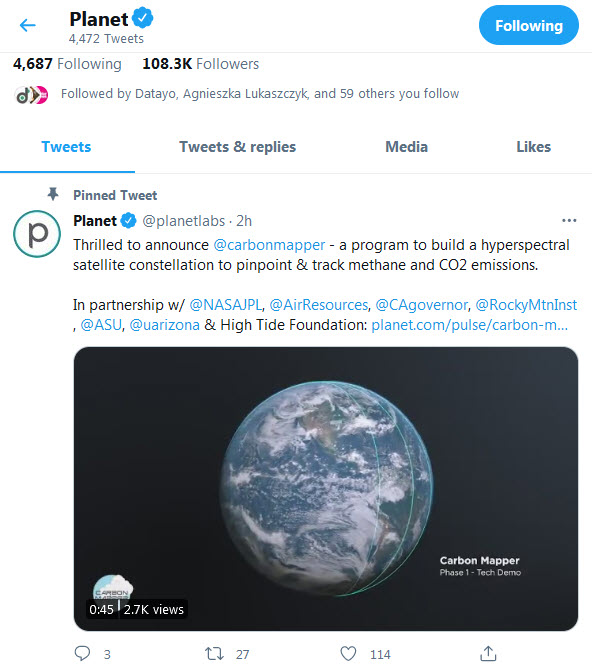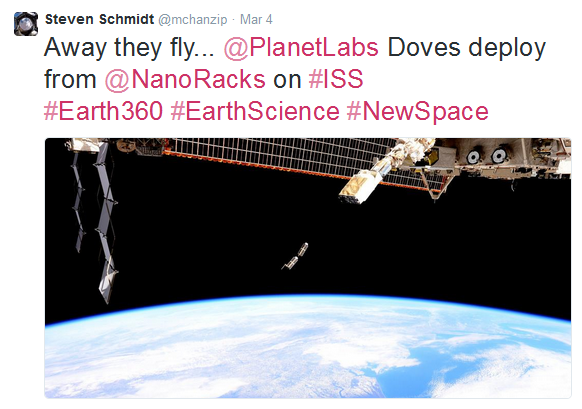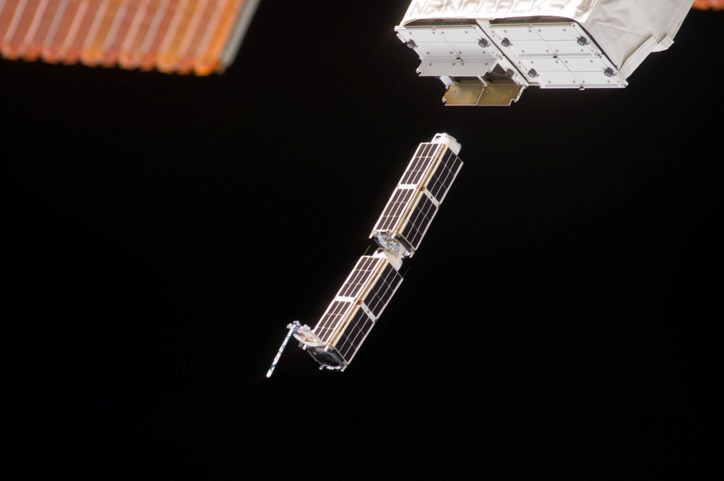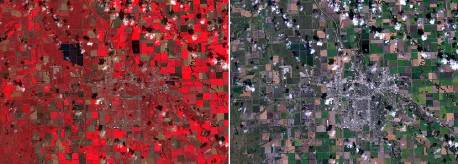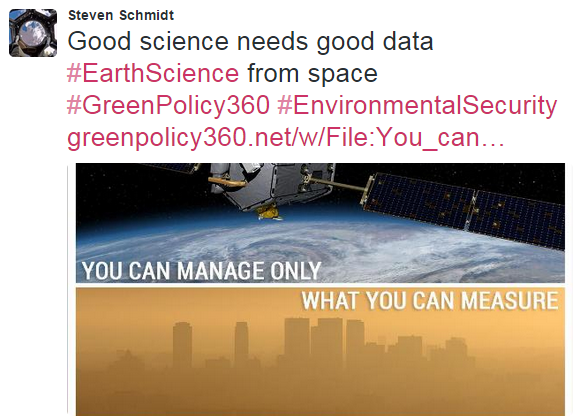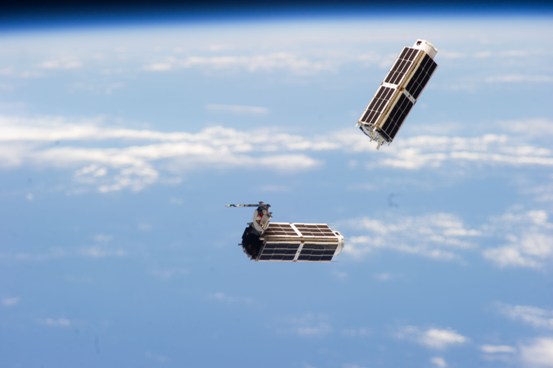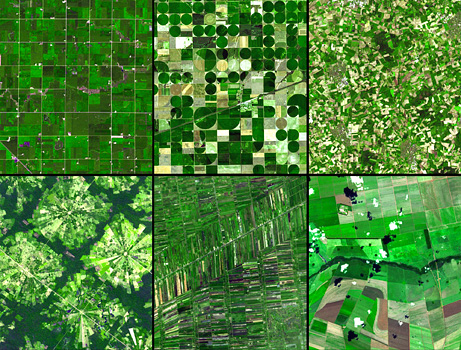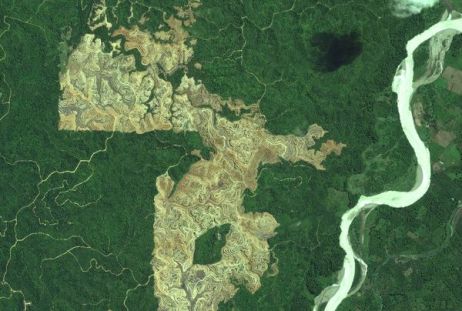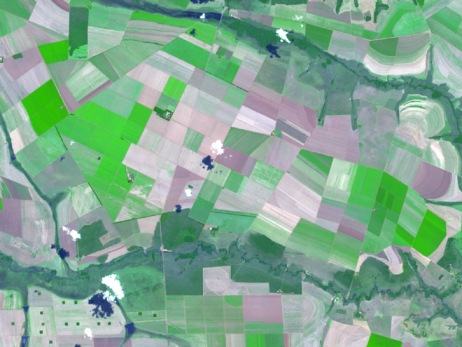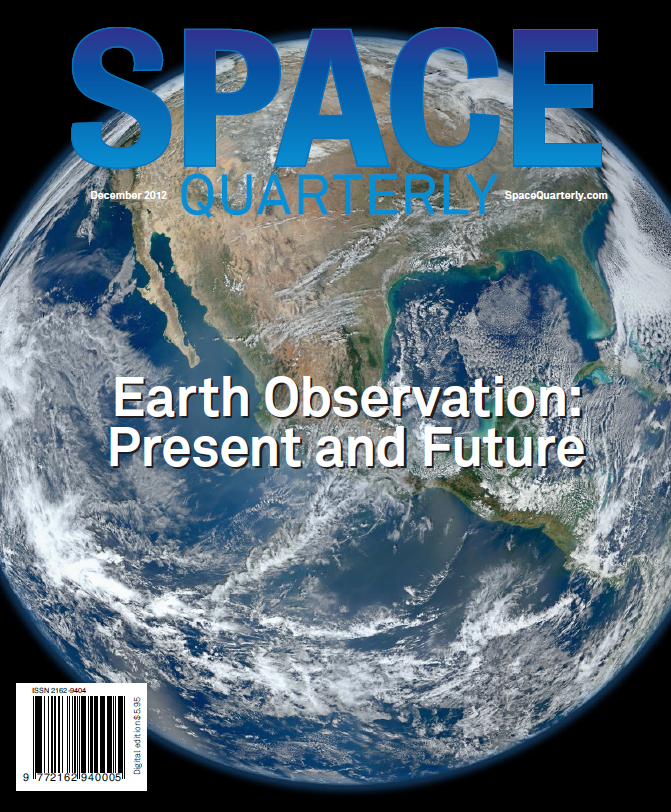Micro-satellites: Difference between revisions
Siterunner (talk | contribs) No edit summary |
Siterunner (talk | contribs) No edit summary |
||
| (132 intermediate revisions by the same user not shown) | |||
| Line 1: | Line 1: | ||
| |||
<big><big><big>''' "New Space", Earth Science from Space'''</big></big></big> | |||
<big>'''''[http://www.greenpolicy360.net/w/Category:Earth_Imaging Earth Imaging] ... [http://www.greenpolicy360.net/w/Earth_Science Earth Science] ... [https://www.greenpolicy360.net/w/Category:Earth_Observations Earth Observations] ...'''''</big> | |||
[[File:NASAblog iss051e050137.jpg]] | |||
| |||
[[File:Dove minisat launch from ISS m.png]] | |||
| |||
:::[[File:Planet 4-15-2021 10-22-51 AM.jpg]] | |||
[https://arstechnica.com/science/2020/07/how-small-satellites-are-radically-remaking-space-exploration/ <big><big>'''How small satellites are radically remaking earth science'''</big></big>] | |||
''Now, two emerging technologies may propel NASA and the rest of the world into an era of faster, low-cost exploration. Instead of spending a decade or longer planning and developing a (beyond-Earth) mission, then spending hundreds of millions (to billions!) of dollars bringing it off, perhaps we can fly a mission within a couple of years for a few tens of millions of dollars. This would lead to more exploration and also democratize access to the Solar System.'' | |||
''The various components of satellites, from propulsion to batteries to instruments, are being miniaturized. It's not quite like a mobile phone, which today has more computing power than a machine that filled a room a few decades ago. But small satellites are following the same basic trend line... the potential of tiny satellites is no longer theoretical. Two years ago, a pair of CubeSats built by NASA (and called MarCO-A and MarCO-B) launched along with the InSight mission. In space, the small satellites deployed their own solar arrays, stabilized themselves, pivoted toward the Sun, and then journeyed to Mars.'' | |||
·········································································································· | |||
<big><big>'''Eyes in the Sky, Monitoring the Earth by Satellite'''</big></big> | |||
:<big>'''[[Democratization of Space]]'''</big> | |||
:<big>'''[[Planet Labs Doves Fly]]'''</big> | |||
:<big>'''[[Planet API]]'''</big> | |||
[[File:Away fly the Doves March4,2015.png]] | [[File:Away fly the Doves March4,2015.png]] | ||
''' | :[[File:You can manage only what you can measure Dr David Crisp, OCO-2, June 2014 m.jpg]] | ||
<big><big>'''''2020'''''</big></big> | |||
<big><big>''[[Earth Science Research from Space]]''</big></big> | |||
<big>'''''2019/2018'''''</big> | |||
* [https://twitter.com/planetlabs/status/984200737126203392?s=09 <big>'''''Timelapse Planet Explorer at Planet.com'''''</big>] | |||
* [https://www.planet.com/pulse/compare-and-timelapse-planet-explorer/ <big>'''''Timelapse Tools: Explorer Lets Anyone Create Stories Of Change'''''</big>] | |||
<big>'''''2017'''''</big> | |||
<big>'''California's Governor Jerry Brown'''</big> | |||
:<big>With a Reputation for Forward-Thinking about Space'''</big> | |||
::<big>Continues to Talk the Big Picture and What Can Be'''</big> | |||
:::[https://www.fastcompany.com/40425808/how-tiny-satellites-are-changing-the-way-we-do-business <big>'''''MicroSats Changing Business on Earth'''''</big>] | |||
::::'''''New Perspectives, New Data is reshaping industries''''' | |||
::[[File:Jerry Brown AGU-Dec14,2016.png]] | |||
''"We got the scientists. We got the lawyers. And we're ready to fight. We're ready to defend. And California is no stranger to this fight...'' | |||
''"California is the future. We are pioneering space...'' | |||
''"Now [https://www.greenpolicy360.net/w/Earth_and_Space,_Politics some people say] they're going to turn off the satellites that are monitoring the climate... low-earth phenomena, the [https://www.greenpolicy360.net/w/Landsat_data_users_handbook LANDSAT] and [https://www.greenpolicy360.net/w/Earth_Science_Research_from_Space all the various measuring satellites that we have]...'' | |||
''"Well, I remember back in 1978 I proposed a LANDSAT satellite for California. They called me 'Governor Moonbeam' because of that. I didn't get that moniker for nothing.'' | |||
''"And if Trump turns off the satellites, [https://www.greenpolicy360.net/w/California_out_in_front_in_a_Green_future California will launch its own (d-mn) satellites!]"'' | |||
'''''2016/2015/2014''''' | |||
<big>'''''Planet Labs [https://www.planet.com/ @planet.com]</big> | |||
:''https://www.planet.com/pulse/'' '''''(PlanetLabs News)''''' | |||
:''https://youtu.be/_6TF7dVXOIM'' '''''(Video)''''' | |||
[http://www.nasa.gov/offices/oct/feature/how-a-nasa-team-turned-a-smartphone-into-a-satellite-business '''''Looking Back: How a NASA Team Turned a Smartphone into a Satellite Business -- Feb 2016'''''] | |||
''""Satellites aren’t small or cheap"". This is changing. The Solar Dynamics Observatory launched by NASA in 2010 weighs about 6,800 pounds and cost $850 million to build and put into orbit.'' | |||
''Even the satellites built under NASA’s Discovery Program, aimed at encouraging development of low-cost spacecraft, still have price tags beyond the reach of smaller companies or research organizations: one such satellite, the sun-particle collecting Genesis, ran up $164 million in expenses despite its modest design and mission.'' | |||
''The change is coming fast as increasingly powerful technology arrives in increasingly smaller packages. For example, in 2010 NASA and the Department of Defense launched the Fast, Affordable, Science and Technology Satellite, aptly called FASTSAT. Weighing in at just 400 pounds, FASTSAT cost just $10 million and carried out six experiments in orbit, proving that low-cost, quick-to-assemble spacecraft were possible.'' | |||
''Think of your own cellphone as a digital brain, a comand-and-control system. Pete Klupar, director of engineering at Ames Research Center, was fond of pulling a government-issued smartphone out of his pocket during speeches and wondering aloud about the phone, which had a faster processor and better sensors than many satellites, and cost so little in comparison — after which he slipped the phone back in his pocket and carried on.'' | |||
''An Ames researcher named Chris Boshuizen took Klupar’s musings to heart. Having seen the phone schtick before, Boshuizen and his colleague '''Will Marshall''' (now of [http://www.greenpolicy360.net/w/Planet_API PlanetLabs]) once interjected during a talk by Klupar when he began to muse aloud about satellite costs.'' | |||
'''''Can you picture it? “Will said, ‘Pete, don’t put that back in your pocket,’” Boshuizen recalls. “‘We’re going to make that into a satellite.’” And then he did exactly that... Hello Planet Labs!''''' | |||
''By September 2013, a NASA team originally led by Boshuizen and Marshall successfully launched its first PhoneSats into low-Earth orbit at a cost of just $7,000 each. Named Alexander, Graham and Bell, the three mini-orbiters took pictures from space and beamed the data back to Earth, demonstrating for the first time that a consumer-grade smartphone could be used to power a satellite in space. Successive generations of 'PhoneSats', launched by NASA and housed inside of 'CubeSats', have since demonstrated increasingly greater capabilities.'' | |||
''Boshuizen and Marshall — joined by Robbie Schingler, another research scientist at Ames — left NASA to found [https://www.planet.com/ '''Planet Labs Inc.'''], focused on using inexpensive, off-the-shelf commercial components to build ever-smaller satellites.'' | |||
''“Instead of doing it the old-school Apollo way, with a lot of system design and analysis and then building the thing at the end, we decided to do it the software way, which is building a minimum-viable prototype first just to show that we have a working model, then going on from there,” Boshuizen says of the process they used to create their satellites, a strategy the company calls “agile aerospace.”'' | |||
''The first prototypes proved promising enough that the company had no trouble raising funds from venture capital in the Silicon Valley near where they had moved. The money allowed the company to hire engineers and produce more of the satellites, named '''Doves''', pioneering what is becoming known as the [http://www.greenpolicy360.net/w/Category:Democratization_of_Space "Democratization of Space"], focusing on earth science. Unlike the first generation of satellites that focused on military operations and communication services, the [http://www.greenpolicy360.net/w/Category:New_Space New Space] satellites have broadened toward earth studies and are improving with each iteration. Launching in space from the International Space Station's newly developed release platform system with another New Space start-up, [http://www.greenpolicy360.net/w/Category:NanoRacks NanoRacks], the future of earth-facing micro-satellites looks promising, especially for myriad [http://www.greenpolicy360.net/w/Category:Earth_Science earth science] open applications like Planet Labs' [http://www.greenpolicy360.net/w/Category:Planet_API Planet API].'' | |||
''By February 2014, the company dispatched the first of its commercial “flock,” when 28 Doves were released from the ISS. These were followed by further deployments that brought the fleet’s total to more than 130 satellites — enough to produce high-resolution imagery of nearly the entire globe on a daily basis.'' | |||
''“We’re going to be gaining insight into the changing planet in a way no one’s ever gotten before...”'' | |||
*'''''California and Silicon Valley digital technology power up a new industry and new ways of seeing and studying our world''''' | |||
*''"New Space" - https://www.greenpolicy360.net/w/Earth_Imaging-New_Space'' | |||
[[File:PlanetLabs homepage2016.png|link=https://youtu.be/_6TF7dVXOIM]] | |||
<big><font color=blue>○ ○ ○ ○ ○ ○ ○</font></big> <big><font color=green>○ ○ ○ ○ ○ ○ ○</font></big> | |||
=== [http://www.planetcitizens.org '''''#PlanetCitizens'''''] === | |||
[http://www.greenpolicy360.net/w/Category:Earth_Science_from_Space ''''''Planet Citizen' Earth Science from Space'''''] | |||
[http://www.greenpolicy360.net/w/Earth_Science_Research_from_Space '''''Earth Science Research from Space'''''] | |||
[https://www.greenpolicy360.net/w/Global_Fishing_Watch '''''Global Fishing Watch: Pioneering Resource Sustainability'''''] | |||
:'''''Managing the Oceans, the 'High Seas', the Commons''''' | |||
○ | |||
'''''Building an API for the Planet: Will Marshall/PlanetLabs''''' [http://m.youtube.com/watch?v=2vYwaBWlVyI] | '''''Building an API for the Planet: Will Marshall / PlanetLabs''''' [http://m.youtube.com/watch?v=2vYwaBWlVyI Watch the Video] | ||
'''''Mission: Democratising Access to Information About the Changing Planet''''' [http://vimeo.com/88602839] | '''''Mission: Democratising Access to Information About the Changing Planet''''' [http://vimeo.com/88602839] | ||
[http://www.greenpolicy360.net/w/Category:NanoRacks '''''NanoRacks, Science and Earth Observation Platform in Space'''''] | |||
'''''Time for Planet Labs 'Doves' to fly''''' [http://www.greenpolicy360.net/w/Planet_Labs_Doves_Fly ''#Micro-satellite_Doves fly''] | '''''Time for Planet Labs 'Doves' to fly''''' [http://www.greenpolicy360.net/w/Planet_Labs_Doves_Fly ''#Micro-satellite_Doves fly''] | ||
[http://www.nasa.gov/mission_pages/station/research/news/girl_scouts_orbital_2/ ''"Girl Scouts"''] [http://www.planet.com/flock1/ ''"Flock 1"''] | [http://www.nasa.gov/mission_pages/station/research/news/girl_scouts_orbital_2/ ''"Girl Scouts -- Orbital"''] [http://www.planet.com/flock1/ ''"Flock 1"''] | ||
[http://nanoracks.com/nanoracks-successfully-deploys/ '''''NanoRacks Deploys'''''] | |||
''http://nanoracks.com/wp-content/uploads/NanoRacks-Release-36-NanoRacks-Successfully-Deploys-After-On-Orbit-Repairs.pdf'' | ''http://nanoracks.com/wp-content/uploads/NanoRacks-Release-36-NanoRacks-Successfully-Deploys-After-On-Orbit-Repairs.pdf'' | ||
| Line 35: | Line 171: | ||
''''' | [http://en.wikipedia.org/wiki/Miniaturized_satellite '''''Wiki looks at 'small sats/micro sats/mini sats'''''] | ||
'''''Wiki looks at "NewSpace"''''' [http://en.wikipedia.org/wiki/NewSpace] [http://en.wikipedia.org/wiki/Low_Earth_orbit] | |||
''''' | '''''Nextgen #earthscience:''''' A New Era studying '''''#climatechange''''' and '''''#globalsecurity''''' | ||
''''' | [http://spectrum.ieee.org/aerospace/satellites/9-earthimaging-startups-to-watch '''''“Five years from now, there might be 200 or more up there..."'''''] | ||
<big><font color=blue>○ ○ ○ ○ ○ ○ ○ ○ ○ ○ ○ ○ ○</font></big> | |||
'''Geoscience Satellites''' -- '''Start-up companies''' | '''Geoscience Satellites''' -- '''Start-up companies''' | ||
| Line 61: | Line 201: | ||
'''OpenNEX, NASA asks public to join in with space data monitoring earth''' [http://www.greenpolicy360.net/w/NASA_EarthSciences,_Challenges_Public_to_Join_In] | '''OpenNEX, NASA asks public to join in with space data monitoring earth''' [http://www.greenpolicy360.net/w/NASA_EarthSciences,_Challenges_Public_to_Join_In] | ||
[[File: | [[File:Good science needs good data .png]] | ||
'''''On the launch of Planet Labs 'Dove' | |||
::[[File:Doves launched from ISS float against Earth horizon s.jpg]] | |||
<big><big>'''Planet Citizens Sends Doves to Fly'''</big></big> | |||
[https://www.greenpolicy360.net/w/GreenPolicy360-eOS#New_Vision_in_a_360.C2.B0_Connected_World '''New Vision in a 360 Connected World'''] | |||
'''Digital knowledge and #OpenData utilized in new ways by #PlanetCitizens''' | |||
'''Applications designed, developed, launched and new apps yet-to-be developed''' | |||
'''''On the launch of Planet Labs 'Dove' nanosatellites''''' | |||
'''''Robbie Schingler, co-founder of Planet Labs: “We are motivated to make information about the changing planet available to all people, especially the people who need it the most..."''''' | '''''Robbie Schingler, co-founder of Planet Labs: “We are motivated to make information about the changing planet available to all people, especially the people who need it the most..."''''' | ||
"The imagery could be used by anyone who cares about changes in land use over time.” [http://www.spacenews.com/article/civil-space/35980planet-labs-unveils-plan-to-launch-28-nanosats-on-antares-1st-cargo-run] | "The imagery could be used by anyone who cares about changes in land use over time.” [http://www.spacenews.com/article/civil-space/35980planet-labs-unveils-plan-to-launch-28-nanosats-on-antares-1st-cargo-run] | ||
'''''"Rapid cadence imagery, like Planet Labs is developing, helps us become better, more sustainable stewards of Earth." [http://bits.blogs.nytimes.com/2014/03/17/qa-with-steve-jurvetson-space-investor-and-rocket-maker/]''''' | '''''"Rapid cadence imagery, like Planet Labs is developing, helps us become better, more sustainable stewards of Earth." [http://bits.blogs.nytimes.com/2014/03/17/qa-with-steve-jurvetson-space-investor-and-rocket-maker/]''''' | ||
Will Marshall, co-founder of Planet Labs talks of democratization of space: videos [https://www.youtube.com/watch?v=Affs5XQkLmY] [https://www.youtube.com/watch?v=04dK7swPSwE] | Will Marshall, co-founder of Planet Labs talks of democratization of space: videos [https://www.youtube.com/watch?v=Affs5XQkLmY] [https://www.youtube.com/watch?v=04dK7swPSwE] | ||
| Line 123: | Line 279: | ||
_ _ _ _ _ _ _ _ _ _ _ _ _ _ _ _ _ _ _ _ _ _ _ _ _ _ _ _ _ _ _ _ _ _ _ _ _ _ _ _ | |||
“With all these start-ups, the things you’ll be able to do with satellite images will grow exponentially..." IEEE, May 2014 | “With all these start-ups, the things you’ll be able to do with satellite images will grow exponentially..." IEEE, May 2014 | ||
_ _ _ _ _ _ _ _ _ _ _ _ _ _ _ _ _ _ _ _ _ _ _ _ _ _ _ _ _ _ _ _ _ _ _ _ _ _ _ _ | _ _ _ _ _ _ _ _ _ _ _ _ _ _ _ _ _ _ _ _ _ _ _ _ _ _ _ _ _ _ _ _ _ _ _ _ _ _ _ _ | ||
| Line 165: | Line 320: | ||
* New micro-satellites, including those launched from the ISS, aim to make real-time imaging available for a fraction of the past decades price and '''move us from military-defense-communication operations to economic/entrepreneurial functions, 'earth systems-monitoring' and biosphere sustainability, space 'tourism' and low earth orbit travel...''' | * New micro-satellites, including those launched from the ISS, aim to make real-time imaging available for a fraction of the past decades price and '''move us from military-defense-communication operations to economic/entrepreneurial functions, 'earth systems-monitoring' and biosphere sustainability, space 'tourism' and low earth orbit travel...''' | ||
'''''New Space | <big>'''''New Space, Planet Citizens, Earth Science, NextGen Tech @Work'''''</big> | ||
'''''Earth systems monitoring''''' - http://www.earthzine.org/geo-and-geoss-the-group-on-earth-observations-and-the-global-earth-observations-system-of-systems/ | '''''Earth systems monitoring''''' - http://www.earthzine.org/geo-and-geoss-the-group-on-earth-observations-and-the-global-earth-observations-system-of-systems/ | ||
| Line 188: | Line 343: | ||
[[File:Geosciences Brazil Terra satellite b.jpg]] | [[File:Geosciences Brazil Terra satellite b.jpg]] | ||
| Line 231: | Line 387: | ||
Share-able earth science data enabling earth biosphere systems monitoring/preservation policy advocacy by #globalcitizen orgs | Share-able earth science data enabling earth biosphere systems monitoring/preservation policy advocacy by #globalcitizen orgs | ||
_ _ _ _ _ _ _ _ _ _ _ _ _ _ _ _ _ _ _ _ _ | _ _ _ _ _ _ _ _ _ _ _ _ _ _ _ _ _ _ _ _ _ | ||
'''Earth systems, monitoring over time''' | |||
'''Earth systems, monitoring over time''' | |||
* http://www.earthzine.org/geo-and-geoss-the-group-on-earth-observations-and-the-global-earth-observations-system-of-systems/ | |||
'''GEO''' - Group on Earth Observations - http://www.earthobservations.org/about_geo.shtml | '''GEO''' - Group on Earth Observations - http://www.earthobservations.org/about_geo.shtml | ||
: '''GEOSS''' - Global Earth Observation System of Systems - http://www.earthobservations.org/geoss.shtml | : '''GEOSS''' - Global Earth Observation System of Systems - http://www.earthobservations.org/geoss.shtml | ||
_ _ _ _ _ _ _ _ _ _ _ _ _ _ _ _ _ _ _ _ _ _ _ _ _ | |||
; <big><big>'''''Our Space/Environmental Mission'''''</big></big> | |||
'''''@ GreenPolicy360, our space/environmental science/physics focus is on being front-of-mind, creating and developing the field of environmental security via a "democratization of space".''''' | |||
[http://www.greenpolicy360.net/w/Category:Earth_Science_from_Space '''''"NewSpace"] is in its first stages and it's an exciting time to be a [http://www.planetcitizen.org Planet Citizen] and sharing [http://www.greenpolicy360.net/w/Citizen_Science citizen science] about #Earth360...''''' | |||
'''''Fleets of micro-satellites and start-up companies pioneering the exploration and study of earth and earth's resources from the vantage point of space offer critically important data.''''' | |||
'''''Unprecedented digital connectivity, networking and availability of data via the World Wide Net-Internet make possible nextgen [http://www.greenpolicy360.net/w/Category:Earth_Science #EarthScience].''''' | |||
'''''It is time, from a unique overview of our blue planet enabled from space, to address climate issues, sustainability challenges, and a host of existential challenges.''''' | |||
It | '''''It's time for an Earth point of view!''''' | ||
[[File:Space-Quarterly-Earth Observations NanoRacks.png]] | |||
○ | |||
[[Category:California]] | |||
[[Category:Democratization of Space]] | [[Category:Democratization of Space]] | ||
[[Category:Digital Citizen]] | |||
[[Category:Earth Imaging]] | |||
[[Category:Earth Observations]] | [[Category:Earth Observations]] | ||
[[Category:EarthPOV]] | |||
[[Category:Earth Science]] | [[Category:Earth Science]] | ||
[[Category:Earth Science from Space]] | |||
[[Category:Eco-nomics]] | |||
[[Category:Environmental Security]] | [[Category:Environmental Security]] | ||
[[Category:Environmental Security, National Security]] | [[Category:Environmental Security, National Security]] | ||
[[Category:Global Security]] | [[Category:Global Security]] | ||
[[Category:Internet]] | |||
[[Category:NASA]] | |||
[[Category:New Space]] | [[Category:New Space]] | ||
[[Category:Planet Citizen]] | [[Category:Planet Citizen]] | ||
[[Category:Planet Scientist]] | [[Category:Planet Scientist]] | ||
[[Category:Planet Citizens, Planet Scientists]] | [[Category:Planet Citizens, Planet Scientists]] | ||
[[Category: | [[Category:Strategic Demands]] | ||
[[Category:Whole Earth]] | |||
[[Category:World Wide Web]] | |||
[[Category:Atmospheric Science]] | [[Category:Atmospheric Science]] | ||
| Line 290: | Line 463: | ||
[[Category:Planetary Science]] | [[Category:Planetary Science]] | ||
[[Category:Space Science and Space Physics]] | [[Category:Space Science and Space Physics]] | ||
[[Category:Strategic Demands]] | |||
[[Category: | |||
[[Category:Earth360]] | [[Category:Earth360]] | ||
[[Category:EarthPOV]] | [[Category:EarthPOV]] | ||
[[Category:ISS]] | |||
[[Category:Micro-satellites]] | |||
[[Category:NanoRacks]] | |||
[[Category:Planet API]] | |||
[[Category:PlanetLabs]] | [[Category:PlanetLabs]] | ||
Latest revision as of 15:34, 15 April 2021
"New Space", Earth Science from Space
Earth Imaging ... Earth Science ... Earth Observations ...
How small satellites are radically remaking earth science
Now, two emerging technologies may propel NASA and the rest of the world into an era of faster, low-cost exploration. Instead of spending a decade or longer planning and developing a (beyond-Earth) mission, then spending hundreds of millions (to billions!) of dollars bringing it off, perhaps we can fly a mission within a couple of years for a few tens of millions of dollars. This would lead to more exploration and also democratize access to the Solar System.
The various components of satellites, from propulsion to batteries to instruments, are being miniaturized. It's not quite like a mobile phone, which today has more computing power than a machine that filled a room a few decades ago. But small satellites are following the same basic trend line... the potential of tiny satellites is no longer theoretical. Two years ago, a pair of CubeSats built by NASA (and called MarCO-A and MarCO-B) launched along with the InSight mission. In space, the small satellites deployed their own solar arrays, stabilized themselves, pivoted toward the Sun, and then journeyed to Mars.
··········································································································
Eyes in the Sky, Monitoring the Earth by Satellite
2020
Earth Science Research from Space
2019/2018
2017
California's Governor Jerry Brown
- With a Reputation for Forward-Thinking about Space
- Continues to Talk the Big Picture and What Can Be
- New Perspectives, New Data is reshaping industries
"We got the scientists. We got the lawyers. And we're ready to fight. We're ready to defend. And California is no stranger to this fight...
"California is the future. We are pioneering space...
"Now some people say they're going to turn off the satellites that are monitoring the climate... low-earth phenomena, the LANDSAT and all the various measuring satellites that we have...
"Well, I remember back in 1978 I proposed a LANDSAT satellite for California. They called me 'Governor Moonbeam' because of that. I didn't get that moniker for nothing.
"And if Trump turns off the satellites, California will launch its own (d-mn) satellites!"
2016/2015/2014
Planet Labs @planet.com
- https://www.planet.com/pulse/ (PlanetLabs News)
- https://youtu.be/_6TF7dVXOIM (Video)
Looking Back: How a NASA Team Turned a Smartphone into a Satellite Business -- Feb 2016
""Satellites aren’t small or cheap"". This is changing. The Solar Dynamics Observatory launched by NASA in 2010 weighs about 6,800 pounds and cost $850 million to build and put into orbit.
Even the satellites built under NASA’s Discovery Program, aimed at encouraging development of low-cost spacecraft, still have price tags beyond the reach of smaller companies or research organizations: one such satellite, the sun-particle collecting Genesis, ran up $164 million in expenses despite its modest design and mission.
The change is coming fast as increasingly powerful technology arrives in increasingly smaller packages. For example, in 2010 NASA and the Department of Defense launched the Fast, Affordable, Science and Technology Satellite, aptly called FASTSAT. Weighing in at just 400 pounds, FASTSAT cost just $10 million and carried out six experiments in orbit, proving that low-cost, quick-to-assemble spacecraft were possible.
Think of your own cellphone as a digital brain, a comand-and-control system. Pete Klupar, director of engineering at Ames Research Center, was fond of pulling a government-issued smartphone out of his pocket during speeches and wondering aloud about the phone, which had a faster processor and better sensors than many satellites, and cost so little in comparison — after which he slipped the phone back in his pocket and carried on.
An Ames researcher named Chris Boshuizen took Klupar’s musings to heart. Having seen the phone schtick before, Boshuizen and his colleague Will Marshall (now of PlanetLabs) once interjected during a talk by Klupar when he began to muse aloud about satellite costs.
Can you picture it? “Will said, ‘Pete, don’t put that back in your pocket,’” Boshuizen recalls. “‘We’re going to make that into a satellite.’” And then he did exactly that... Hello Planet Labs!
By September 2013, a NASA team originally led by Boshuizen and Marshall successfully launched its first PhoneSats into low-Earth orbit at a cost of just $7,000 each. Named Alexander, Graham and Bell, the three mini-orbiters took pictures from space and beamed the data back to Earth, demonstrating for the first time that a consumer-grade smartphone could be used to power a satellite in space. Successive generations of 'PhoneSats', launched by NASA and housed inside of 'CubeSats', have since demonstrated increasingly greater capabilities.
Boshuizen and Marshall — joined by Robbie Schingler, another research scientist at Ames — left NASA to found Planet Labs Inc., focused on using inexpensive, off-the-shelf commercial components to build ever-smaller satellites.
“Instead of doing it the old-school Apollo way, with a lot of system design and analysis and then building the thing at the end, we decided to do it the software way, which is building a minimum-viable prototype first just to show that we have a working model, then going on from there,” Boshuizen says of the process they used to create their satellites, a strategy the company calls “agile aerospace.”
The first prototypes proved promising enough that the company had no trouble raising funds from venture capital in the Silicon Valley near where they had moved. The money allowed the company to hire engineers and produce more of the satellites, named Doves, pioneering what is becoming known as the "Democratization of Space", focusing on earth science. Unlike the first generation of satellites that focused on military operations and communication services, the New Space satellites have broadened toward earth studies and are improving with each iteration. Launching in space from the International Space Station's newly developed release platform system with another New Space start-up, NanoRacks, the future of earth-facing micro-satellites looks promising, especially for myriad earth science open applications like Planet Labs' Planet API.
By February 2014, the company dispatched the first of its commercial “flock,” when 28 Doves were released from the ISS. These were followed by further deployments that brought the fleet’s total to more than 130 satellites — enough to produce high-resolution imagery of nearly the entire globe on a daily basis.
“We’re going to be gaining insight into the changing planet in a way no one’s ever gotten before...”
- California and Silicon Valley digital technology power up a new industry and new ways of seeing and studying our world
- "New Space" - https://www.greenpolicy360.net/w/Earth_Imaging-New_Space
○ ○ ○ ○ ○ ○ ○ ○ ○ ○ ○ ○ ○ ○
#PlanetCitizens
'Planet Citizen' Earth Science from Space
Earth Science Research from Space
Global Fishing Watch: Pioneering Resource Sustainability
- Managing the Oceans, the 'High Seas', the Commons
○
Building an API for the Planet: Will Marshall / PlanetLabs Watch the Video
Mission: Democratising Access to Information About the Changing Planet [1]
NanoRacks, Science and Earth Observation Platform in Space
Time for Planet Labs 'Doves' to fly #Micro-satellite_Doves fly
"Girl Scouts -- Orbital" "Flock 1"
Doves deployment into space continues [2] [3][4] [5]
Wiki looks at 'small sats/micro sats/mini sats
Wiki looks at "NewSpace" [6] [7]
Nextgen #earthscience: A New Era studying #climatechange and #globalsecurity
“Five years from now, there might be 200 or more up there..."
○ ○ ○ ○ ○ ○ ○ ○ ○ ○ ○ ○ ○
Geoscience Satellites -- Start-up companies
BlackBridge [8], Dauria [9], DigitalGlobe [10] [11] [12] GeoEye [13],
Firefly Space Systems [14] [15], GeoOptics [16], NanoRacks [17], [18] [19]
NovaWurks [20], OmniEarth [21] [22] [23] [24], OrbitLogic [25], PlanetiQ [26]
Planet Labs [27] Pulse [28] [29] [30], RapidEye [31], Skybox [32] [33] [34]
Teledyne [35], Tyvak Nano-Sat [36], Urthecast [37]
OpenNEX, NASA asks public to join in with space data monitoring earth [38]
Planet Citizens Sends Doves to Fly
New Vision in a 360 Connected World
Digital knowledge and #OpenData utilized in new ways by #PlanetCitizens
Applications designed, developed, launched and new apps yet-to-be developed
On the launch of Planet Labs 'Dove' nanosatellites
Robbie Schingler, co-founder of Planet Labs: “We are motivated to make information about the changing planet available to all people, especially the people who need it the most..."
"The imagery could be used by anyone who cares about changes in land use over time.” [39]
"Rapid cadence imagery, like Planet Labs is developing, helps us become better, more sustainable stewards of Earth." [40]
Will Marshall, co-founder of Planet Labs talks of democratization of space: videos [41] [42]
Planet Labs, the largest fleet of Earth-imaging satellites... the 'Doves'...
The data is expansive and of added value over time:
- - humanitarian applications, earth resource monitoring, sustainability and eco-nomics
- - extreme event and disaster relief
- - food systems, water distribution, improving agriculture
- - business intelligence (BI) metrics/performance
- - research, science
_ _ _ _ _ _ _ _ _ _ _
New Space News
Q2-Q3 2014
Google Buys Skybox [43] [44] [45] [46]
[Background] June 18, 2013 Inside a Startup’s Plan to Turn a Swarm of DIY Satellites Into an All-Seeing Eye [47]
June 16, 2014 - Wall Street Journal / by Christopher Mims [48]
By 2016 or so, Skybox will be able to take full images of the Earth twice a day, at a resolution that until last week was illegal to sell commercially — all with just a half-dozen satellites.
By the time its entire fleet of 24 satellites has launched in 2018, Skybox will be imaging the entire Earth at a resolution sufficient to capture, for example, real-time video of cars driving down the highway. And it will be doing it three times a day.
You might think, thanks to weather maps and the satellite view on Google Maps, that such imagery already is readily available. But because satellites were, until recently, so expensive to build and launch, that isn't the case. There are only nine satellites in orbit now that capture high resolution images for the commercial market, and their capabilities are regularly commandeered for national-security purposes by the U.S. government. That means most of the pictures of the Earth that you've seen are of poor quality and years out of date.
At Google, the business of Skybox isn't data, but knowledge. "We think we are going to fundamentally change humanity's understanding of the economic landscape on a daily basis," says Skybox co-founder Dan Berkenstock...
Skybox's images will inevitably lead to apps and services no one can envision — with unknowable disruptive potential. Skybox executives tell me they hope to offer their data to outside developers... In the short term, Google has said it would use Skybox's images to improve the search company's maps.
A patent revealed in May indicates that Google builds its superaccurate maps directly from satellite imagery, and the company has long had a deal with Skybox competitor DigitalGlobe, whose satellites cost 10 times as much as Skybox's and are 10 times heavier, leading to much higher launch costs. DigitalGlobe's stock dipped 4% on news of the Skybox deal...
_ _ _ _ _
Skybox and Planet Labs / re Google's purchase of Skybox, Google has a business division called “Earth Enterprise” that provides mapping data for large organizations, institutions and businesses. “Google Earth Enterprise allows you to store and process terabytes of imagery, terrain and vector data on your own server infrastructure, and publish maps securely for your users to view using Google Earth desktop or mobile apps, or through your own application using the Google Maps API..." [49]
Planet Labs versus Skybox / The next step is something more like a Google for Earth: a search engine where people can find satellite photos taken in real or near-real time that answer questions like “How many ships are in the Port of Houston today?” or “How much corn is currently growing in Iowa?” [50]
_ _ _ _ _ _ _ _ _ _ _ _ _ _ _ _ _ _ _ _ _ _ _ _ _ _ _ _ _ _ _ _ _ _ _ _ _ _ _ _
“With all these start-ups, the things you’ll be able to do with satellite images will grow exponentially..." IEEE, May 2014
_ _ _ _ _ _ _ _ _ _ _ _ _ _ _ _ _ _ _ _ _ _ _ _ _ _ _ _ _ _ _ _ _ _ _ _ _ _ _ _
U.S. Department of Commerce lifts ban on satellite images showing features smaller than 20 inches - DigitalGlobe [51] [52] [53] [54]
- "Companies had not been allowed to make use of images where features smaller than 50cm were visible"
- Satellites Are Cleared to Take Photos at Mailbox-Level Detail per DigitalGlobe petition
- Worldview-3 satellite is set to launch in August. Digital Globe [55] [56] says it will now be able to sell images that show features as small as 31cm [57]
- Sites like Google and Bing Maps will be able to use higher-quality satellite images in near real-time [58] [59]... eventually real-time
_ _ _ _ _
GP360: Earth-monitoring, data-sharing, open source, is coming out from the wings...
Citizen-networking/schools-education space-earth projects -- education looks at #earthscience from space... [60] [61]
24/7 high-definition video of Earth <Urthecast-ISS> [62] Urthecast APIs
Live from the International Space Station [63] [64] [65] [66]
Earth sciences/NASA-JPL and gov contractors 'Eyes on the Earth'
Q1 2014
Until recently, since the launch of the original Landsat program in 1972, generating images of Earth from space has been the near-exclusive domain of enormous, multi-million dollar satellites sponsored by nations and major defense corporations.
- New micro-satellites, including those launched from the ISS, aim to make real-time imaging available for a fraction of the past decades price and move us from military-defense-communication operations to economic/entrepreneurial functions, 'earth systems-monitoring' and biosphere sustainability, space 'tourism' and low earth orbit travel...
New Space, Planet Citizens, Earth Science, NextGen Tech @Work
Earth systems monitoring - http://www.earthzine.org/geo-and-geoss-the-group-on-earth-observations-and-the-global-earth-observations-system-of-systems/
<more> http://gizmodo.com/meet-the-flockers-iss-launches-low-cost-earth-imaging-1517232660
Earth Imaging -- Acquiring large data sets of Earth imagery in a simple, low-cost way, represents a new market opportunity beginning to be addressed. New telescope designs enable low-cost satellites with that purpose. [67]
"Flocking" "Doves" "Nanosatellites" - http://www.scientificamerican.com/article/flock-of-nano-satellites-to-capture-high-res-views-of-whole-earth/
Google goes mapping - http://gizmodo.com/how-swarms-of-tiny-satellites-are-creating-a-real-time-1497890594
Swarms of small satellites set to deliver close to real-time imagery - http://www.nature.com/news/many-eyes-on-earth-1.14475
Q4 2013
"How Planet Labs Is Saving the Earth with 'Homemade' Satellites. It took less than six months to build twenty-eight of them"...
<more> http://www.businessinsider.com/planet-labs-fleet-of-homemade-satellites-2013-12?op=1
http://www.space.com/23739-tiny-earth-satellite-fleet-launching-december.html
Flock of Mini- and Micro-sats delivered to space with international Dnepr co-venture - http://www.space.com/23738-dnepr-rocket-launches-32-satellites.html
Minotaur 1 delivers 29 mini "CubeSats" including first-ever design/build satellite project of a US high school' -
http://www.orbital.com/NewsInfo/MissionUpdates/MinotaurI_ORS-3/
_ _ _ _ _
CubeSats - CubeSat specifications accomplish several high-level goals. Simplification of the satellite's infrastructure makes it possible to design and produce workable satellites at low cost.... Encapsulation of the launcher–payload interface takes away the prohibitive amount of managerial work... Unification among payloads and launchers enables quick exchanges of payloads and utilization of launch opportunities... #CubeSats #Nanosatellites #Satdat
CubeSat 'nano-satellites' aim to adhere to the standards described in the CubeSat design specification -- CubeSats initiatives were conceived from educational institutions... In 2004, with their relatively small size, first-gen CubeSats could each be made and launched to Low-Earth Orbit (LEO) for an estimated $65,000–$80,000. Acc to Wikipedia, 'recent' launch prices have been $100,000-$125,000, plus approximately $10,000 to construct a CubeSat. This price tag, far lower than most satellite launches, has made CubeSat a viable option for schools and universities across the world.
LightSail with CubeSats, Planetary Society - Launch date April 2016 [68] Video/July 2014 Explore Planets/TW
Q3 2013
Sensors and Systems - “Every year the technology improves, with better computers and storage and payloads. The technological evolution improves, price points continue to come down, and now with a small 150 to 300 kg spacecraft for $10 to $20 million you can do what you were doing with a 1,000 kg spacecraft five to 10 years ago for $500 million.” Surrey Satellite Technology-RapidEye satellite imagery “Changing the Economics of Space” ... co-ventures/joint ventures/'ride-alongs'/shared platforms/accessible data
<more> http://www.sstl.co.uk/ - note connection to SpaceX - Elon Musk - note Elon Muck opening up the Tesla platform on June 12, 2014 - http://en.wikipedia.org/wiki/Surrey_Satellite_Technology - http://www.teslamotors.com/blog/all-our-patent-are-belong-you
Q2 2013
Citizens in Space - http://www.citizensinspace.org/2013/06/planet-labs-to-launch-flock-1/
Opening up to understanding and interacting with our eco-operating systems
Share-able earth science data enabling earth biosphere systems monitoring/preservation policy advocacy by #globalcitizen orgs
_ _ _ _ _ _ _ _ _ _ _ _ _ _ _ _ _ _ _ _ _
Earth systems, monitoring over time
GEO - Group on Earth Observations - http://www.earthobservations.org/about_geo.shtml
- GEOSS - Global Earth Observation System of Systems - http://www.earthobservations.org/geoss.shtml
_ _ _ _ _ _ _ _ _ _ _ _ _ _ _ _ _ _ _ _ _ _ _ _ _
- Our Space/Environmental Mission
@ GreenPolicy360, our space/environmental science/physics focus is on being front-of-mind, creating and developing the field of environmental security via a "democratization of space".
"NewSpace" is in its first stages and it's an exciting time to be a Planet Citizen and sharing citizen science about #Earth360...
Fleets of micro-satellites and start-up companies pioneering the exploration and study of earth and earth's resources from the vantage point of space offer critically important data.
Unprecedented digital connectivity, networking and availability of data via the World Wide Net-Internet make possible nextgen #EarthScience.
It is time, from a unique overview of our blue planet enabled from space, to address climate issues, sustainability challenges, and a host of existential challenges.
It's time for an Earth point of view!
○
- California
- Democratization of Space
- Digital Citizen
- Earth Imaging
- Earth Observations
- EarthPOV
- Earth Science
- Earth Science from Space
- Eco-nomics
- Environmental Security
- Environmental Security, National Security
- Global Security
- Internet
- NASA
- New Space
- Planet Citizen
- Planet Scientist
- Planet Citizens, Planet Scientists
- Strategic Demands
- Whole Earth
- World Wide Web
- Atmospheric Science
- Biogeosciences
- Climate Change
- Cryosphere
- Geophysics and Geochemistry
- Mineralogy
- Geology
- Geophysics
- Hydrology
- Natural Resources
- Ocean Science
- Planetary Science
- Space Science and Space Physics
- Earth360
- ISS
- Micro-satellites
- NanoRacks
- Planet API
- PlanetLabs


